This post may contain affiliate links. Please read our disclosure policy.

Introducing Fonio Balls in Peanut Sauce! Have you guys ever heard of Fonio before?
It’s the name of a small grain that has been used for thousands of years in West Africa. Fonio looks a bit like brown sugar; it’s a very small grain. It’s naturally gluten-free, has an earthy, nutty flavor, and has a texture similar to couscous when cooked. It’s also rich in fiber, protein, iron, and calcium. I still wonder why I didn’t try it sooner!
These fonio balls are super tender and served in an African-inspired peanut sauce. Ready?

We start by cooking the fonio. Since it is a very small grain (a bit smaller than millet), it cooks very quickly. Just 7 minutes in boiling water, and it’s ready!
The mixture for the balls is easy to prepare. You process the cooked fonio, oats, spices, and aromatics like garlic and onion in a food processor until everything is well combined and sticky enough to form balls. For the spices, I went with a mix of ground cumin, chili, paprika, coriander, fenugreek, and cinnamon. This mix is inspired by famous African spice blends like Ras el Hanout or Berbere. If you have those in your pantry, feel free to use them instead of the different spices.
Once the balls are shaped, shallow-fry in a skillet until golden brown. What I like about these fonio balls is how well they hold together. You don’t have to worry about them falling apart.

Now onto the sauce! Cook some onions, garlic, and ginger until fragrant, then add carrots and red bell peppers. The addition of carrots and peppers not only adds sweetness but also gives the dish more texture. I personally like to keep the carrots slightly crunchy.

When the carrots are cooked, pour in the full-fat coconut milk, a generous amount of natural peanut butter, water to thin out, spices, and some coconut sugar to balance with the spices.
Do not try to reduce the amount of peanut butter or use light coconut milk; it just won’t be as good. Okay, the sauce is rich, but it’s really the star of the dish.
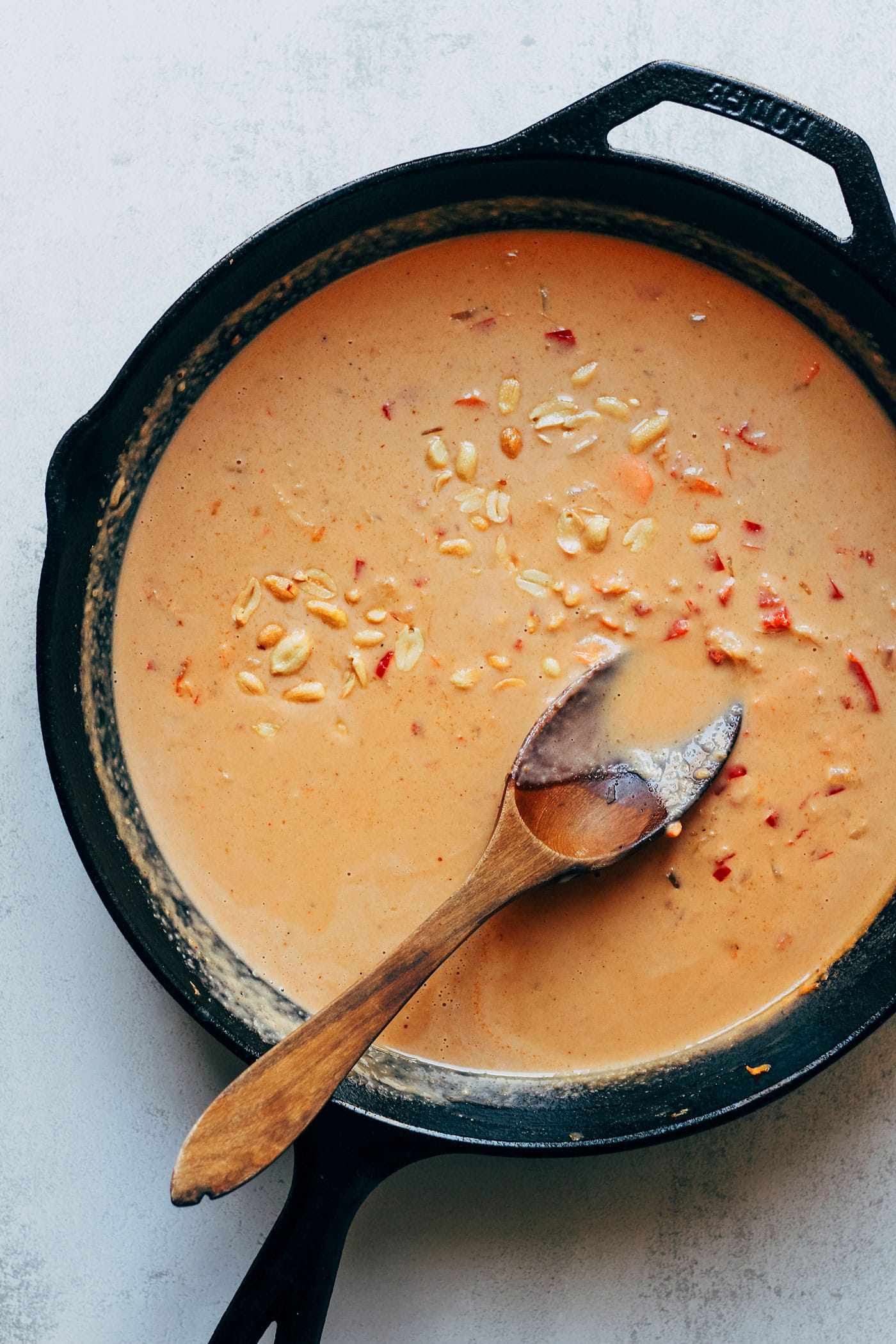
Finally, add the fonio balls to the sauce, stir to coat, and let simmer for a few more minutes to let the balls soak up the flavors of the sauce.
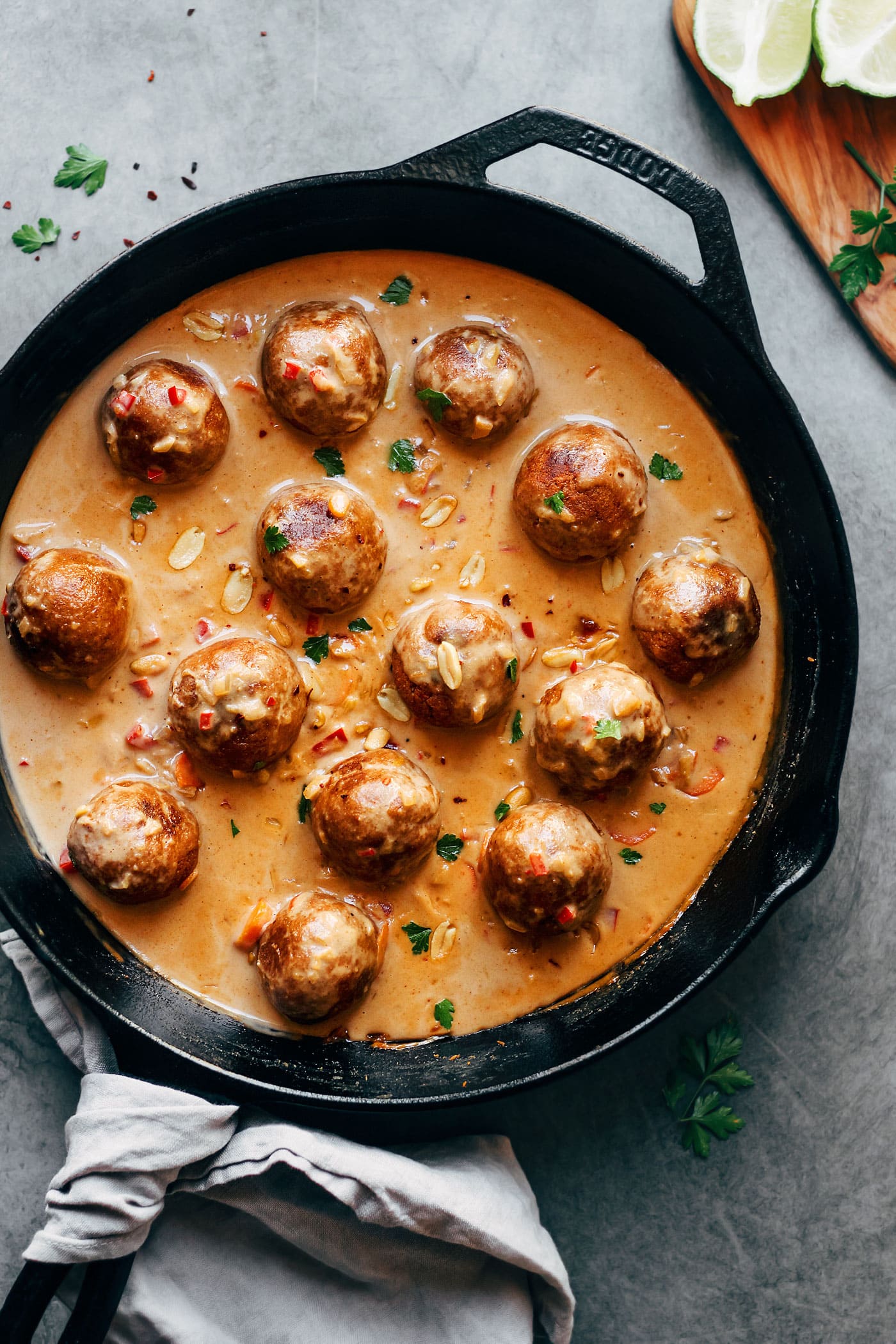
These fonio balls are delicious with a simple green salad or on top of rice for a filling and nutritious meal. I’m sure you will love this recipe. It’s tender, creamy, and packed with flavor. Seriously!
If you are looking for more recipes using fonio, stay tuned. I have a few more in the works!
Let me know in the comments if you try this recipe!
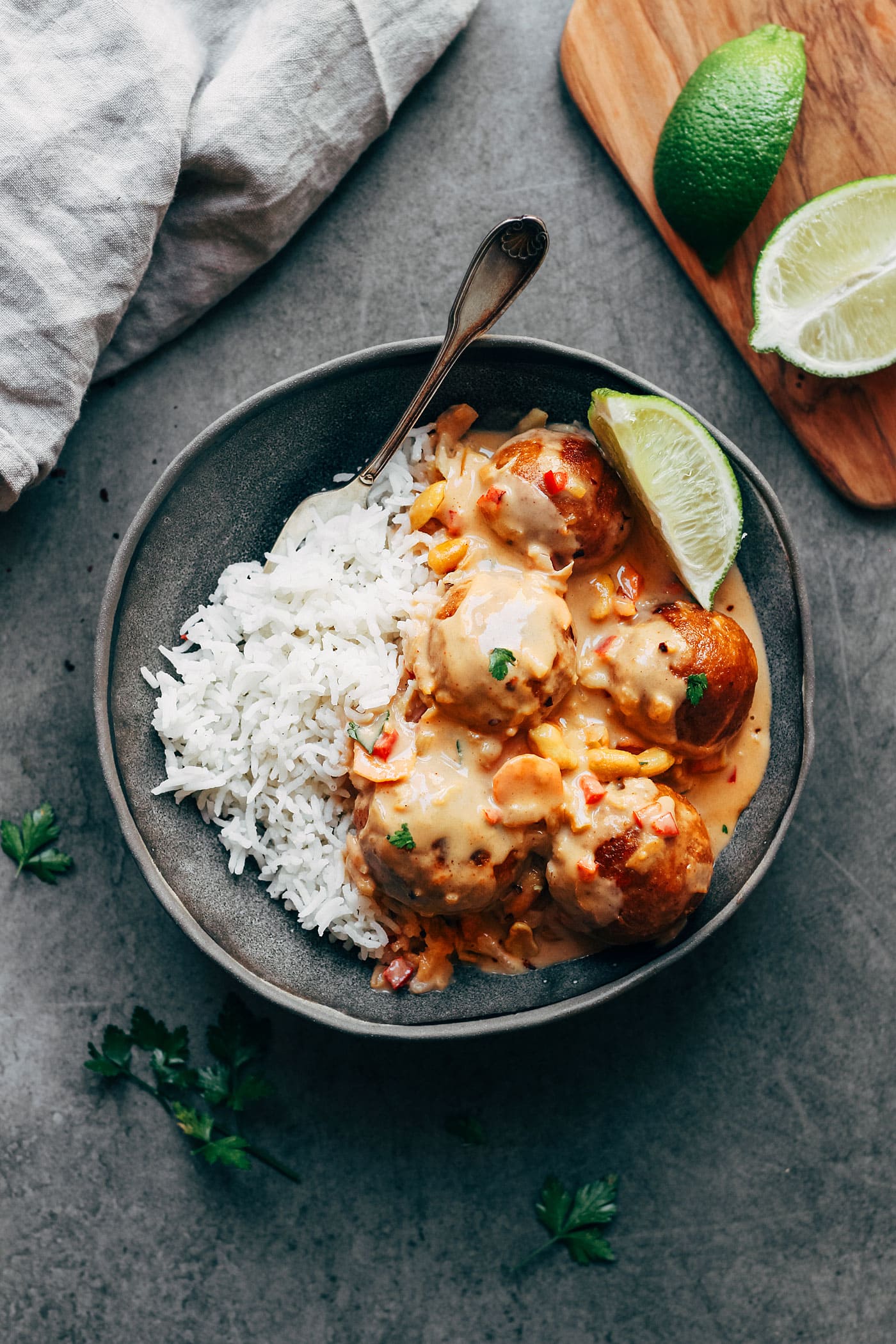

Want to Save This Recipe?
Enter your email below & we’ll send it straight to your inbox! Plus, you will receive new recipes every week!
I’d like to receive more tips & recipes from Full of Plants.
This site is protected by reCAPTCHA and the Google Privacy Policy and Terms of Service apply.
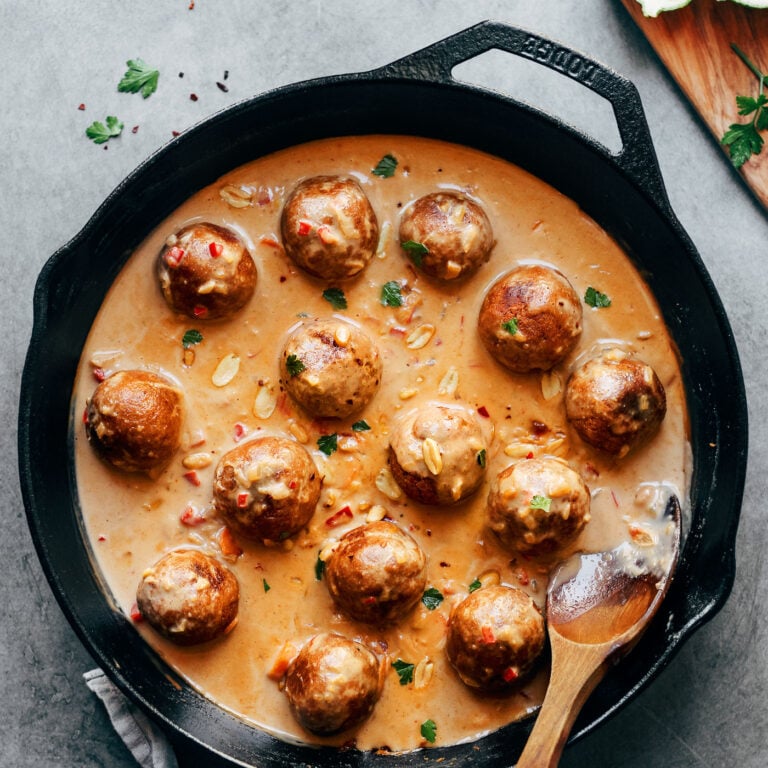
Fonio Balls in Peanut Sauce
Ingredients
Fonio Balls
- 1 cup (200 g) fonio
- 2 and 1/2 cup (600 ml) water
- 1/4 tsp salt
- 1/2 cup (40 g) quick oats or rolled oats
- 1/2 tsp harissa paste
- 1/2 onion diced
- 1 clove of garlic
- 2 tsp cumin
- 1 tsp ground chili
- 1 tsp each: paprika and coriander
- 1/2 tsp fenugreek
- 1/4 tsp cinnamon
- 1/8 tsp cayenne pepper
- 2 tbsp (28 g) tomato paste
Coconut Peanut Sauce
- 1 tbsp (15 ml) oil
- 1 onion diced
- 2 cloves of garlic minced
- 1 tsp freshly grated ginger
- 1 carrot finely sliced
- 1/2 red bell pepper diced
- 1 13.5-ounce (1 400-ml can) can full-fat coconut milk
- 1/3 cup (80 g) peanut butter
- 1/2 cup (120 ml) water you might have to use 3/4 cup
- 1 tbsp (14 g) tomato paste
- 1 tsp (5 g) coconut sugar
- 1/2 tsp ground chili
- 1/4 tsp salt
- 1/4 cup (30 g) roasted peanuts
Instructions
Fonio Balls
- Heat a teaspoon of oil in a large saucepan over medium heat. Add the fonio and toast for 1-2 minutes, stirring frequently. Add the water and salt, and bring to a boil. Reduce to a simmer and cook until no liquid remains, about 7-8 minutes.
- Transfer the cooked fonio to the bowl of a food processor. Add the oats, harissa paste, onion, garlic, spices, and tomato paste. Process for 20-30 seconds, scraping down the sides regularly until everything is well combined and the mixture is sticky enough to form balls. Taste and adjust seasonings if needed.
- Using your hands, form balls (about 3 tablespoons of the mixture per ball). Transfer to a large plate or dish lined with parchment paper and set aside. You should get about 12 balls.
- Heat a tablespoon of oil in a large non-stick skillet over medium heat. Once hot, add the balls and rotate the skillet to coat the balls with oil. Cook for about 5 minutes, stirring regularly until the balls are golden brown on each side. Remove from heat and cover to keep warm.
Coconut Peanut Sauce
- Heat the oil in a large skillet over medium heat. Once hot, add onion, garlic, and grated ginger. Cook for 1 minute. Add the carrot and red bell pepper, and cook for 5-8 minutes or until the carrots are soft.
- Pour in the coconut milk, peanut butter, water, tomato paste, coconut sugar, ground chili, and salt. Stir well to combine everything. For a thinner sauce, use 3/4 cup water instead of 1/2 cup. Taste and adjust salt or sugar if needed. Cook for another 3-5 minutes.
- Transfer the fonio balls to the sauce and stir to coat. Cook for 2 minutes. Top with peanuts, red pepper flakes, and fresh parsley. Serve immediately on top of rice or simply with a green salad.
Nutrition

About the Author
Thomas Pagot is the founder, photographer, and recipe developer behind Full of Plants. He created the blog in 2016 as a personal cookbook for vegan recipes. Through years of recipe development, Thomas has successfully grown Full of Plants into a trusted resource for plant-based recipes.

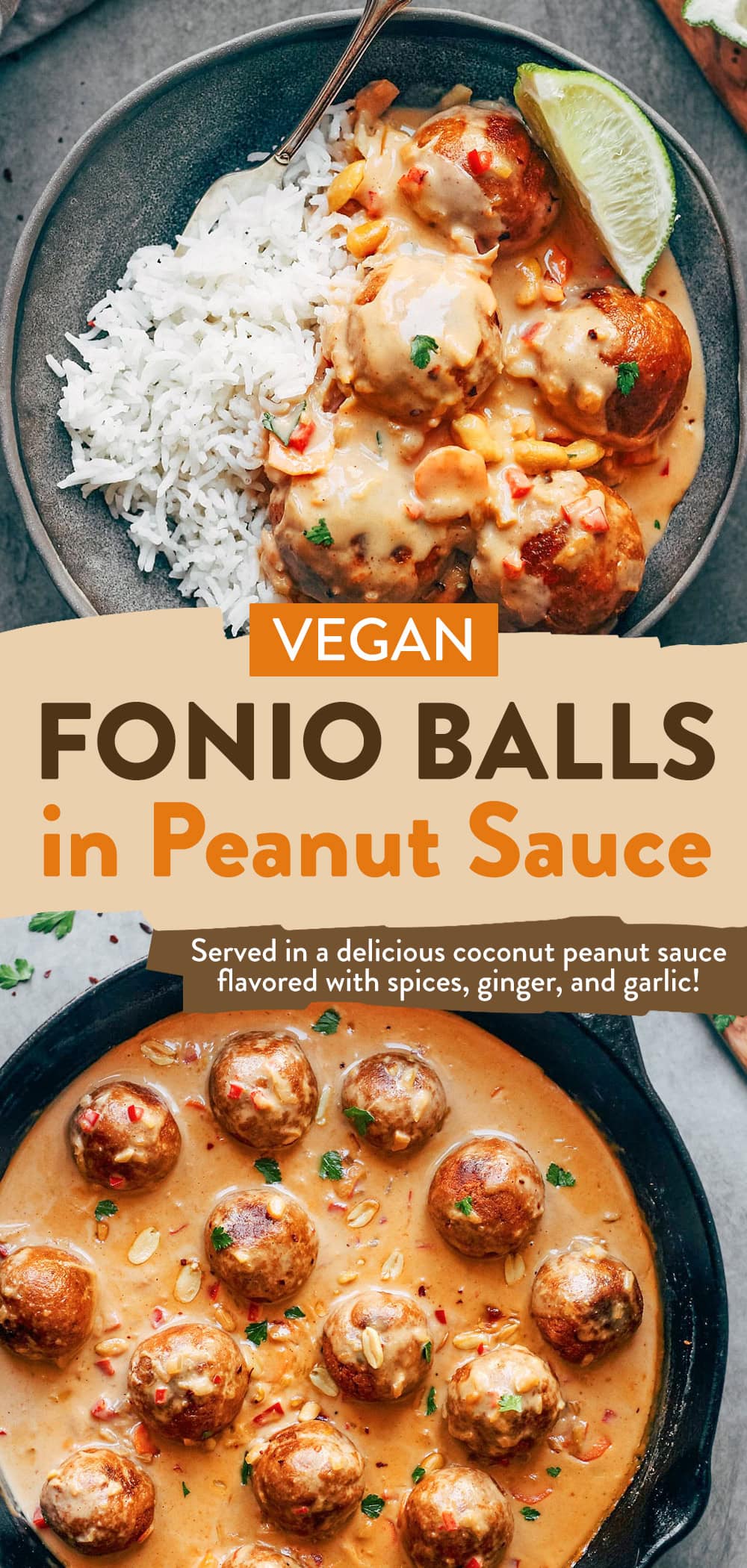
Leave a Comment
Salut Thomas, just made these, I agree the recipe makes TONS on balls. Also, next time I may add more oats, the fonio balls are quite thick and sticky. And perhaps a light blending of the sauce, to make it a tiny bit smoother. Eager to experiment with it, merci pour la recette, une découverte!
Salut !
De rien, je suis content que tu ai apprécié cette recette 😉
Hi there,
Is it possible to make the balls ahead and freeze them?
Hi Tasha,
I haven’t tried freezing the balls, so I can’t say for sure, sorry.
Great recipe! Will definitely make it again.
Thanks Hilda!
I love this! I think it’s a pretty forgiving recipe: I was missing all kinds of things from harissa to fresh ginger to red bell peppers and even the abridged version was very flavorful. The balls taste North African to me. My Ghanaian husband didn’t love them but of course he enjoyed the sauce. Our 3yo daughter had fun rolling the balls with me.
Thanks for your feedback Hélène!
I like the sauce and it was interesting trying this grain for the first time. A couple observations for those making this recipe:
Number of fonio balls: I can’t imagine how big these would be if you made only 12-14 from the amount of grain, oats, and other ingredients called for. I made 4 dozen out of the recipe; these were about the size of traditional Swedish meatballs. I thought the smaller size was good given the desire to have these absorb the flavor of the sauce (perhaps 1.5″ in diameter). Overall, it makes much more than 4 servings. I’ve had two already and hardly made a dent in the overall amount.
Sauteing the fonio balls: I found this difficult with just a little oil and had to add more–almost like a shallow deep fry–and keep it very hot to prevent the grain from sticking to the pan.
Sauce: I would have doubled the amount of sauce (or used half the fonio ball recipe) if I knew how much would be absorbed by the fonio balls. The relative amount of sauce to fonio balls is decreased dramatically the next day much as if you have pasta in a soup that absorbs the liquid.
“Temperature” of the spices. The base flavor of the sauce is good, and the peanut butter and tomato paste amounts seemed well balanced. I’m someone who typically thinks recipes are too salty and I order a medium or lower spice level at restaurants. However, I would have liked this quite a bit spicier and saltier. Next time, I will add more heat from more harissa paste, garlic, and chili pepper. I used a spicy ancho-chili pepper mix, but my harissa paste was rather mild.
Thanks for your deep feedback!
Am sooo curious to try fornio – ( never heard of it before) the recipe sounds awesome… can you suggest an alternative ?
I would think wheat semolina would make a good alternative, but you won’t have the same nutty/earthy flavor.
Hi! Didn’t care for the “meatball”, I’m not a huge grains fan. So no reflection on your recipe…..but the sauce is to die for! Not a huge pb fan but this is amazing. You might wonder if I don’t care for grains and pb why would I make this recipe lol someone else made it at work for our vegan option today.
Hi June,
Glad you liked the sauce 🙂 Thanks for your feedback!
as an answer to ‘wash’/rinse foni or not…
Like rice you can rinse the foni and the effect in both cases is it will be ‘less sticky’ after rinse… so in this recipe I suggest not to rinse because you want them sticky to form balls….
Yes please more fonio recipes ! Fonio grain pancakes ? 🙂
Will take into consideration 🙂
I have made this recipe and it’s outstanding. But I have one question. Fenugreek seeds or leaves?
Thanks Beth! 🙂 Fenugreek powder, or dried leaves ground into a powder.
I can’t wait to try this!!
Hello Thomas—
I also think this recipe is quite creative—and I also find the word “Barbarian” quite offensive. I can assure you that it is quite derogatory. I understand that you don’t mean it that way, but sometimes we use language/expressions without knowing where they come from. There are many words in Spanish and in English that I grew up using and that have colonial origins that I wasn’t aware of; I used them without realizing that they were demeaning even to me as a speaker of those languages who does not belong to the dominant (European) culture. This is one of the insidious ways in which colonialism is still at work, long after the colonies have ceased to be. Now that I know where those words came from, I can never use them again.
The fact that a word is commonly used does not change where it came from. It may be easy for the dominant culture to ignore where the word came from; it’s not so easy for those who historically have borne the brunt of it.
When someone points out in good faith that a word is hurtful because of its meaning and historical context, it’s usually a good idea to take note; it’s the respectful thing to do. A little bit of humility goes a long way. Could you simply remove the word “barbarian” from your description? The recipe remains the same, and we can all enjoy it.
Thank you.
This is from Merriam-Webster’s Dictionary:
https://www.merriam-webster.com/dictionary/barbarian
Wikipedia also has different meanings, anyway it has been removed.
I just re-read the blog post and saw that you have already removed the word “barbarian.” Thank you. It makes a big difference.
I just re-read the blog post, and I see that you have already removed the word “barbarian.” Thank you. It makes a big difference.
Hi Eva,
You are right, I absolutely don’t mean it the way many people think, that’s why I decided to remove it.
I do believe though that words, no matter where they come from (except very few ones), can be perceived as offensive or not, it all depends on your perspective.
I’m eager to try this recipe. What kind of chile are you referring to when you say “ground chili?” Where I am, there is a huge variety of chiles that are available in ground form. If you don’t know specifically what type of chile it is, what is the flavor like? Is it hot? Sweet? Smoky?
I’m referring to chili mix spice that usually also contains cumin. It’s hot but not as hot as cayenne pepper powder.
Ever tried baking the balls instead of frying?
I have never tried, but these are not deep-fried so it doesn’t absorb too much oil.
I replaced the fonio with millet and it was Delicious! Perfect and comforting for this cold weather.
Thank you!
Thanks Sara!
Do you think that quinoa would work with this recipe, if so what if any changes should be made?
I’m afraid the balls would fall apart if using quinoa.
Well, 1. That’s not the meaning of the word Barbarian; 2. Unknown to who? The grain is literally of West African origin and you’re saying what we call it is the Barbarian name? That’s disrespectful at best, Thomas.
Thomas, thanks for the recipe. Looking forward to trying it. I believe you should delete your barbarian reference – this coming from a professor of humanities
It has been deleted already.
Agreed!!
Unacceptable.
This looks good. I have just come across this grain and went looking for recipes. Several other posts suggest washing fonio before use. What do you think? If I wash it, even with draining well, it will be pretty wet and not very amenable to toasting. Any recommendations or thoughts about rinsing the fonio and then toasting it? Thanks
I would try toasting it and then washing, or just skip the toasting process, it should still taste good 😉
Hi Thomas, I slightly changed your recipes. I added some fish sauce instead of salt and added the zest and juice of 1 lime to add some acidity and decrease a bit the fatness of the peanut butter and coconut milk. Very nice and tanks for the inspiration. I bought my first bag of Folio 2 days ago and was looking for ideas when I found your recipe. You look very young so congratulations for the creativity.
Hi Enrica,
Thanks for sharing your tweaks 😉 Happy to hear you liked the recipe!
Ah, yes I have to update my photo, it’s a few years old now 🙂
Hey Thomas
Do you think I can use Bulgur instead of the fonio to make these balls?
Dish looks delicious, hopefully I’ll make it this evening 😉
grts
Hey Maarten, yes I think bulgur will be a great substitute!
So creative + beautiful!
Thanks Dana!